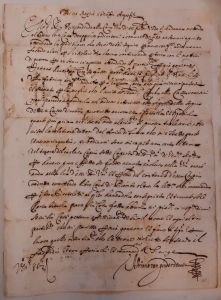MERCANTILE CORRESPONDENCE OF THE SAMINIATI

The Saminiatis were an important family of Tuscan merchants who established significant business relations with traders of various Italian and European cities between the 15th and 17th centuries.
The bond linking Bocconi University and the Saminiati Pazzi Archive is strong, as it was a Bocconi professor of economic history, Armando Sapori, later Rector of the University, who saved this archive. It was then reorganized and inventoried over the course of many years thanks to the dedication of another Bocconian, Davide Groppi, who literally devoted his life to the Saminiati papers.
The core of the collection are the thousands of commercial letters sent by merchants of numerous cities to the Saminiatis and the registers with copies of the letters written and sent by the family from its Tuscan offices.
The project of transcription started in 2023 precisely works on this core. The aim is to encourage research as well as present and disseminate this invaluable material through a portal where the scans of the letters are associated with digital transcriptions of the texts, thus making them searchable by keyword.
PHASES OF THE PROJECT
Document analysis: The first phase of the project was the analysis of the documents from the point of view of their content as a source of economic data.
Selection of a body of letters and codices: On the basis of the research interests of the Bocconi faculty, a chronological period was identified (the years around the plague of 1630), along with registers with copies of outgoing letters and the folders of letters arriving from the main merchants attested in the register itself.
Digitization of documents: As part of the digitization process underway within the Bocconi Historical Archives for purposes of conservation and valorization, the digitization of all the selected materials (correspondence and register) was completed.
Transcription of manuscripts: The implicit objective of the project is to test the application of AI to proceed with an automatic transcription of manuscript texts which would enable an extension of the project to other bodies of documentation; to train the model it is necessary to start from a sufficiently high number of correct transcriptions performed by archivists themselves.
Linguistic analysis: Given the commercial nature of the texts, transcription criteria and the use of tags were defined with a view to their use for creating an automatic transcription model.
Definition and implementation of frontend: Transkribus is the platform chosen for displaying images of the documents associated with text transcriptions, which thus become searchable by keyword.
WORKING GROUP
The project on The mercantile correspondence of the Saminiati family around 1630 was born as a project of the Bocconi Historical Archives for the development and valorization of the fonds, intercepting the research interests of Fabio Gatti working towards his doctorate in Economy at University of Bern.
The coordination, digitalization and implementation of the platform, and updating of the website all pertain to Bocconi Historical Archives.
Digitization of the material was carried out with the contribution of the University of Bern.
CAeB archivists collaborated on the manual transcription.
In 2025, the transcription project was expanded with the addition of further material from the Saminiati Archive. Specifically, new mercantile correspondence from the Florentine bank company of Ascanio Saminiati and Giovacchino Guasconi (1626-1641) was added and the so-called Registro Chellini (“Libro delle ricordanze di Giovanni Chellini”): it’s the oldest document in the Saminiati fonds, which lists the assets of Giovanni Chellini, the main representative of the Tuscan family, but also a valuable testimony of Florentine life between the end of the 14th century and the 15th century.
Thanks to the manual transcription work on the documents selected in the first phase of the project, it was possible to train a new model, which was then used for the automatic transcription of new files. The final version of the texts for online publication was reviewed and corrected by CAeB.
All digitizations used for the project were carried out with specialized scanners by the staff of the Bocconi Historical Archives, who promoted and coordinated the entire project.
Link to the Saminiati project on Transkribus: